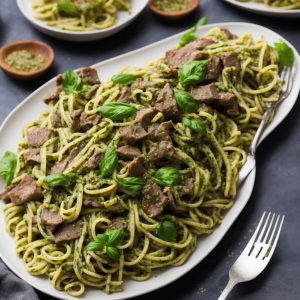This delightful recipe of spaghetti squash, enhanced with the summery flavors of pesto and finished with a touch of fresh tomato, brings a new perspective to your usual pasta dishes. The vibrant freshness of basil and the richness of parmigiano-reggiano in the pesto blend perfectly with the squash's natural sweetness. It's a simple, healthy dish that makes a standout main or side, perfect for both weeknight dinners and special occasions.
While spaghetti squash might not be a staple in all households, it's becoming increasingly popular in supermarkets due to its versatility and health benefits. It's a winter squash that, when cooked, separates into long, pasta-like strands. If you're not familiar with it, look in the produce section of your supermarket - it's usually available year-round. As for the basil and parmigiano-reggiano, these are key ingredients in making a traditional pesto sauce. Fresh basil leaves can be found in the herbs section, and parmigiano-reggiano is a type of Italian cheese found in the dairy or deli section.
Essential Ingredients for Pesto Spaghetti Squash with Tomatoes
Spaghetti squash: A unique vegetable that, when cooked, pulls apart into spaghetti-like strands. It's a great low-carb substitute for pasta.
Basil leaves: Fresh basil lends a distinct and vibrant flavor to pesto sauce.
Garlic clove: Adds a robust flavor to the pesto.
Olive oil: Helps blend the pesto ingredients together and adds richness.
Parmigiano-reggiano: A salty, nutty cheese that enhances the flavor of the pesto sauce.
Salt and fresh pepper: Seasonings to enhance the overall flavor of the dish.
Tomato: Adds a bit of freshness and acidity to balance out the rich pesto.
One reader, Janene Nemeth says:





This pesto spaghetti squash with tomatoes recipe is a game-changer! The flavors are so vibrant and fresh, and the dish is incredibly satisfying. The combination of the pesto and tomatoes with the spaghetti squash is simply divine. It's a must-try for anyone looking for a healthy and delicious meal.
Essential Techniques for Making Pesto Spaghetti Squash with Tomatoes
How to prepare spaghetti squash: Cut the squash in half lengthwise, then scoop out the seeds and fibers. Place in a microwave-safe dish and cover. Microwave for about 8 to 9 minutes. Remove from the microwave and scoop out the flesh with a fork into a large bowl.
How to make pesto: In a small blender, combine the basil, garlic, olive oil, parmesan cheese, salt, and pepper, then purée until smooth.
How to serve: Combine the pesto with 2 cups of spaghetti squash, add tomatoes, then season with additional salt and pepper. Serve warm and enjoy!
How To Make Pesto Spaghetti Squash with Tomatoes
Cut down on carbs with this rich pesto spaghetti squash! It’s bursting with delicious flavors from tomatoes, basil, and garlic for a heartier meal.
Serves:
Ingredients
- 1small spaghetti squash
- 15large basil leaves
- 1small garlic clove
- ¼cupolive oil
- 3tbspparmigiano-reggiano
- salt and fresh pepper
- 1tomato,diced
Instructions
-
Cut the squash in half lengthwise, then scoop out seeds and fibers. Place in a microwave-safe dish and cover.
-
Microwave for about 8 to 9 minutes. Remove from the microwave and scoop out the flesh with a fork into a large bowl.
-
In a small blender, combine the basil, garlic, olive oil, parmesan cheese, salt, and pepper, then purée until smooth.
-
Combine pesto with 2 cups of spaghetti squash. Add tomatoes, then season with additional salt and pepper.
-
Serve warm, and enjoy!
Nutrition
- Calories: 178.04kcal
- Fat: 15.82g
- Saturated Fat: 3.11g
- Monounsaturated Fat: 10.42g
- Polyunsaturated Fat: 1.68g
- Carbohydrates: 7.15g
- Fiber: 1.65g
- Sugar: 2.97g
- Protein: 3.40g
- Cholesterol: 4.74mg
- Sodium: 302.93mg
- Calcium: 110.18mg
- Potassium: 175.62mg
- Iron: 0.57mg
- Vitamin A: 38.18µg
- Vitamin C: 6.40mg
Crucial Technique Tip for Perfecting Pesto Spaghetti Squash
When preparing the spaghetti squash, ensure to scoop out all the seeds and fibers thoroughly. This not only makes the squash easier to cook, but also improves the overall texture and taste of the dish. Additionally, when making the pesto, blend the ingredients until they are completely smooth. This will give your pesto a creamy consistency, enhancing the flavor of the dish.
Time-Saving Tips for Preparing Pesto Spaghetti Squash
Prep ahead: Roast the spaghetti squash in advance and store it in the refrigerator. This will save time when you're ready to make the dish.
Use store-bought pesto: If you're short on time, consider using pre-made pesto sauce instead of making it from scratch.
Multi-task: While the squash is cooking, prepare the pesto and chop the tomatoes to make the most of your time in the kitchen.
Batch cooking: Make a larger portion of the recipe and store the leftovers for a quick and easy meal later in the week.
Invest in a good quality vegetable peeler: A good peeler can make the process of preparing the squash much quicker and easier.
Prep the ingredients: Measure and prepare all the ingredients before you start cooking to streamline the process.
Substitute Ingredients For Pesto Spaghetti Squash with Tomatoes Recipe
spaghetti squash - Substitute with zucchini noodles: Zucchini noodles can be used as a low-carb alternative to spaghetti squash, providing a similar texture and mild flavor.
basil leaves - Substitute with arugula: Arugula can be used as a peppery alternative to basil, adding a slightly different flavor profile to the dish.
garlic clove - Substitute with shallot: Shallots can provide a milder, slightly sweet flavor compared to garlic, adding a unique twist to the dish.
olive oil - Substitute with avocado oil: Avocado oil can be used as a healthier alternative to olive oil, offering a mild flavor and high smoke point for cooking.
parmigiano-reggiano - Substitute with pecorino romano: Pecorino Romano cheese can be used as a substitute for parmigiano-reggiano, providing a similar salty and nutty flavor to the dish.
tomato - Substitute with roasted red peppers: Roasted red peppers can add a sweet and smoky flavor to the dish, serving as an alternative to fresh tomatoes.
How to Beautifully Present This Spaghetti Squash Recipe
Elevate the spaghetti squash: Gently twirl the spaghetti squash onto the plate using tongs to create a visually appealing nest-like shape. This will add a touch of elegance to the dish.
Garnish with basil leaves: Place a few fresh basil leaves on top of the spaghetti squash to add a pop of color and a hint of freshness to the dish.
Drizzle with olive oil: Using a steady hand, drizzle a small amount of high-quality olive oil in a circular motion around the edge of the plate for a sophisticated finishing touch.
Sprinkle with freshly grated parmigiano-reggiano: Grate a small amount of parmigiano-reggiano over the spaghetti squash using a fine grater, ensuring an even distribution of the cheese for a burst of savory flavor.
Arrange tomato slices: Artfully arrange thin slices of ripe tomato around the perimeter of the plate, creating a vibrant and visually appealing border for the dish.
Add a sprinkle of freshly ground black pepper: Just before serving, lightly sprinkle freshly ground black pepper over the spaghetti squash to enhance the flavors and add a touch of warmth to the dish.
Essential Kitchen Tools for Making Pesto Spaghetti Squash
- Microwave-safe dish: A dish that is safe to use in the microwave, typically made of glass or microwave-safe plastic.
- Blender: A kitchen appliance used to blend, purée, or emulsify food and other substances.
- Fork: A utensil with prongs used for picking up and eating food.
- Large bowl: A large, deep dish used for mixing ingredients or serving food.
- Knife: A tool used for cutting and preparing ingredients.
- Cutting board: A flat board used for cutting and preparing food.
- Measuring cup: A tool used to measure liquid or dry ingredients.
- Spoon: A utensil used for stirring, mixing, and serving food.
- Serving dish: A dish used for serving food, typically with an attractive presentation.
Storing and Freezing Pesto Spaghetti Squash: A Guide
- Let the pesto spaghetti squash cool down to room temperature before storing it in an airtight container in the refrigerator. It will keep fresh for up to 3-4 days.
- If you want to freeze the leftovers, transfer the cooled spaghetti squash to a freezer-safe container or resealable plastic bag. Make sure to remove as much air as possible before sealing to prevent freezer burn.
- When freezing, it's best to portion the squash into individual servings so you can easily thaw and reheat the amount you need.
- Label the container or bag with the date and contents for easy identification later on.
- Frozen pesto spaghetti squash can be stored in the freezer for up to 2-3 months without significant loss of flavor or texture.
- To thaw, transfer the frozen squash from the freezer to the refrigerator and let it defrost overnight. Alternatively, you can use the microwave's defrost setting to thaw it more quickly.
- Reheat the thawed spaghetti squash in the microwave or in a skillet over medium heat until it's heated through. Stir occasionally to ensure even heating and prevent burning.
- If the reheated squash seems a bit dry, you can add a splash of olive oil or a bit of water to help moisten it up.
How To Reheat Leftover Pesto Spaghetti Squash with Tomatoes
Preheat your oven to 350°F (175°C). Place the leftover pesto spaghetti squash in an oven-safe dish and cover it with foil. Bake for 15-20 minutes or until heated through. This method helps to retain the moisture and prevent the squash from drying out.
For a quicker option, reheat the spaghetti squash in the microwave. Transfer the leftovers to a microwave-safe dish and cover it with a damp paper towel. Microwave on high for 1-2 minutes, stirring halfway through, until the squash is heated evenly.
If you prefer a crispy texture, reheat the pesto spaghetti squash in a skillet. Add a tablespoon of olive oil to a large skillet over medium heat. Add the leftover squash and sauté for 5-7 minutes, stirring occasionally, until it's heated through and slightly crispy on the edges.
To maintain the freshness of the tomatoes, avoid reheating them with the squash. Instead, dice fresh tomatoes and add them to the reheated squash just before serving. This will provide a burst of fresh flavor and prevent the tomatoes from becoming mushy.
If the reheated pesto spaghetti squash seems a bit dry, add a splash of olive oil or a dollop of fresh pesto to revive the flavors and add moisture. Gently toss the squash to coat it evenly.
Interesting Trivia About Pesto Spaghetti Squash with Tomatoes
Spaghetti squash is a great source of vitamins and minerals, including vitamins A and C, potassium, and fiber. It's also low in calories and carbs, making it a healthy alternative to traditional pasta.
Is Making Pesto Spaghetti Squash at Home Cost-Effective?
The pesto spaghetti squash with tomatoes recipe is quite cost-effective for a household. The main ingredient, spaghetti squash, is affordable and nutritious. The addition of basil, garlic, and tomatoes enhances the flavor without significantly increasing the cost. The use of olive oil and parmigiano-reggiano may slightly elevate the cost, but these ingredients are versatile and can be used in various other dishes. Overall, this recipe offers a balance of affordability and nutrition. Verdict: 9/10. Approximate cost: $12-15.
Is Pesto Spaghetti Squash with Tomatoes Healthy?
This pesto spaghetti squash with tomatoes recipe is a relatively healthy dish, offering several nutritional benefits:
- Spaghetti squash is low in calories and carbohydrates, making it a great alternative to traditional pasta for those watching their calorie intake or following a low-carb diet
- The squash is also rich in fiber, vitamins (especially vitamin C), and minerals like potassium and calcium
- Basil, a key ingredient in the pesto, is packed with antioxidants and anti-inflammatory compounds
- Olive oil provides healthy monounsaturated fats, which can help reduce inflammation and improve heart health
- Tomatoes are an excellent source of lycopene, an antioxidant linked to reduced risk of certain cancers and heart disease
However, there are a few aspects of the recipe that could be adjusted to make it even healthier:
- The dish relies on a significant amount of olive oil and parmesan cheese, which can increase the calorie and fat content. Reducing these ingredients slightly could help lower the overall calorie count without sacrificing taste
- To boost the nutrient profile, consider adding more vegetables to the dish, such as:
- Spinach or kale for an extra dose of vitamins and minerals
- Bell peppers for added crunch and vitamin C
- Zucchini or eggplant for more fiber and antioxidants
- Swapping out some of the parmesan cheese for a sprinkle of nutritional yeast can provide a similar umami flavor while reducing the saturated fat content and adding B vitamins
- If you're looking to increase the protein content, consider adding some cooked chicken, shrimp, or tofu to the dish
Our Editor's Opinion on This Delightful Spaghetti Squash Recipe
This recipe for pesto spaghetti squash with tomatoes is a delightful and healthy dish. The combination of the fresh basil pesto, tender spaghetti squash, and juicy tomatoes creates a burst of flavors and textures. The use of microwave to cook the squash makes it a quick and convenient option for a weeknight meal. The addition of Parmigiano-Reggiano adds a rich and savory note to the dish. Overall, it's a simple yet elegant recipe that is sure to impress with its vibrant colors and delicious taste.
Enhance Your Pesto Spaghetti Squash with Tomatoes Recipe with These Unique Side Dishes:
Delicious Alternatives to Pesto Spaghetti Squash with Tomatoes
Perfect Appetizers and Desserts for a Pesto Spaghetti Squash Dinner
Why trust this Pesto Spaghetti Squash with Tomatoes Recipe:
This recipe uses fresh basil and tomatoes to create a vibrant and flavorful pesto. The use of spaghetti squash as a healthy alternative to traditional pasta adds a unique twist to the dish. The combination of garlic, olive oil, and parmesan-reggiano cheese in the pesto provides a rich and savory taste. The inclusion of microwave instructions makes the preparation quick and convenient. Overall, the use of fresh, wholesome ingredients and simple cooking methods ensures a delicious and trustworthy dish.
Was this page helpful?
Have your own special recipe to share? Submit Your Recipe Today!












